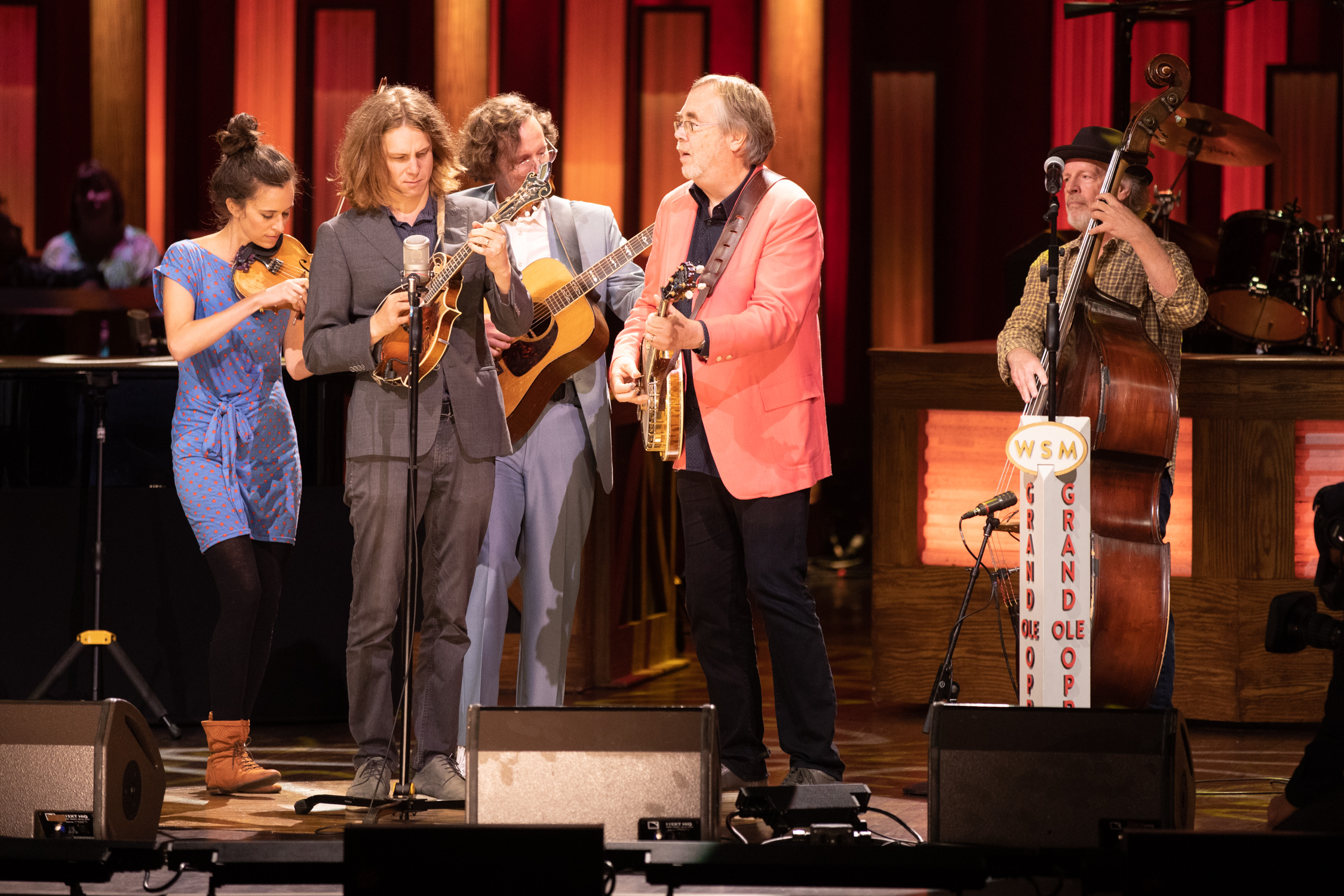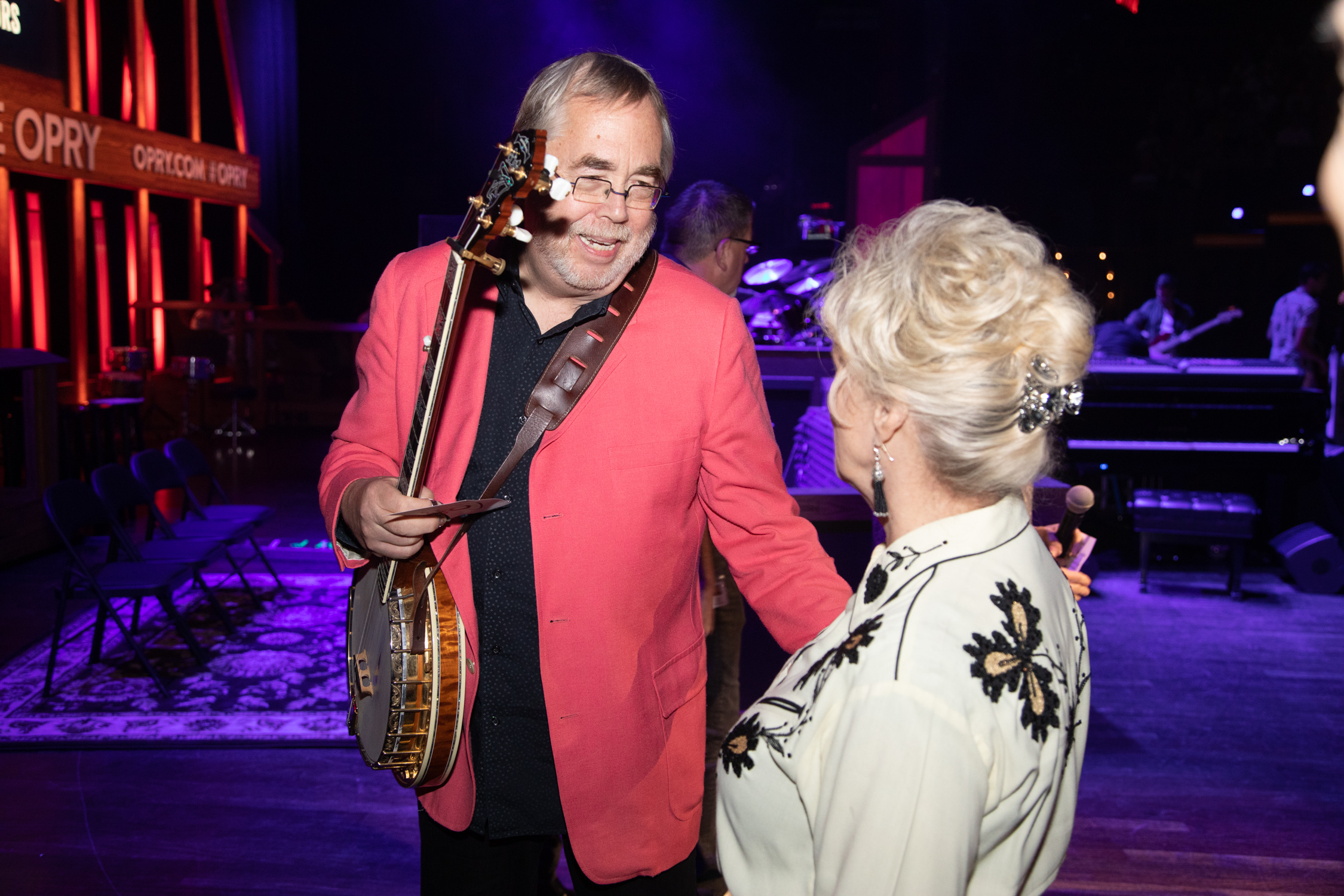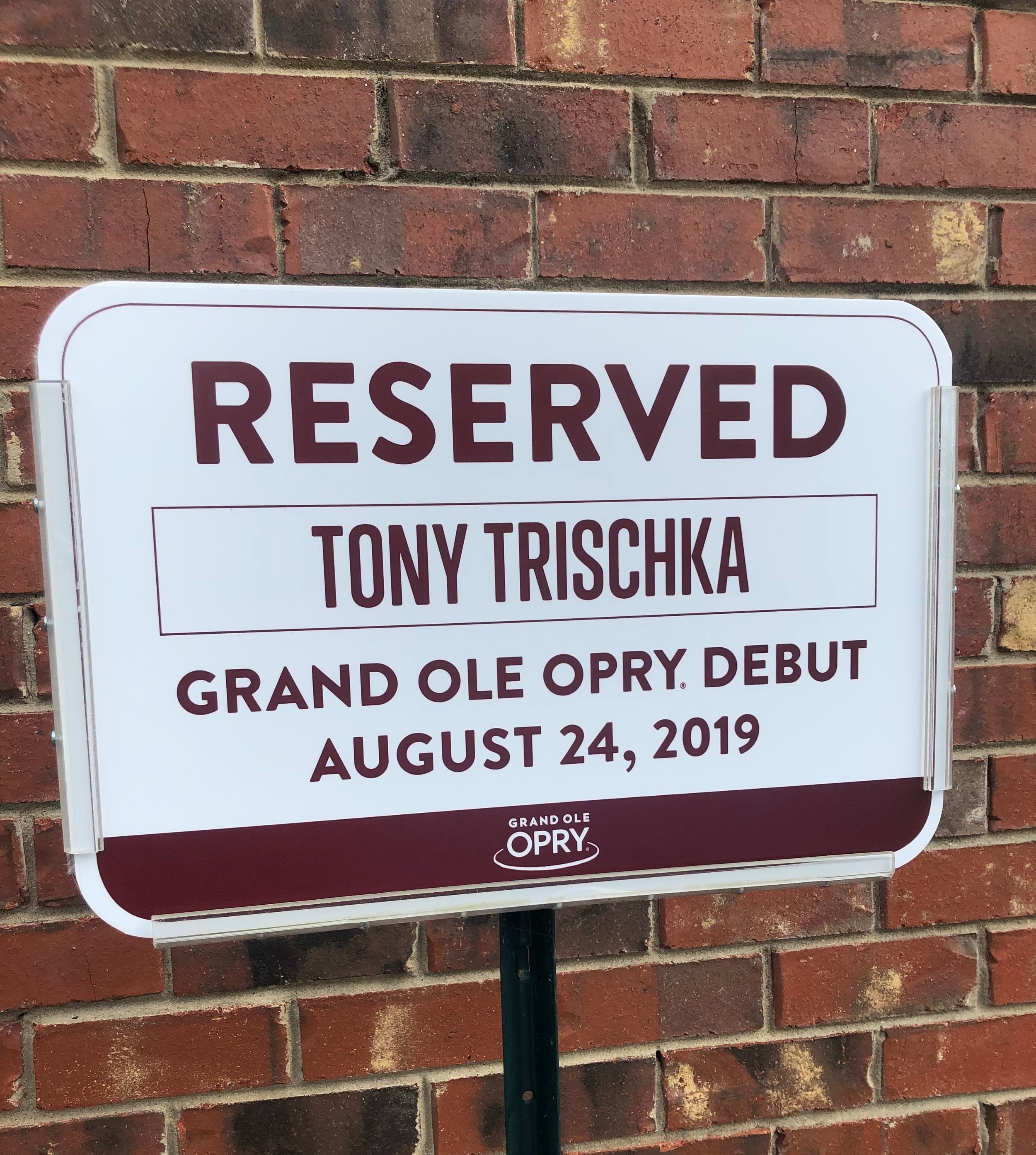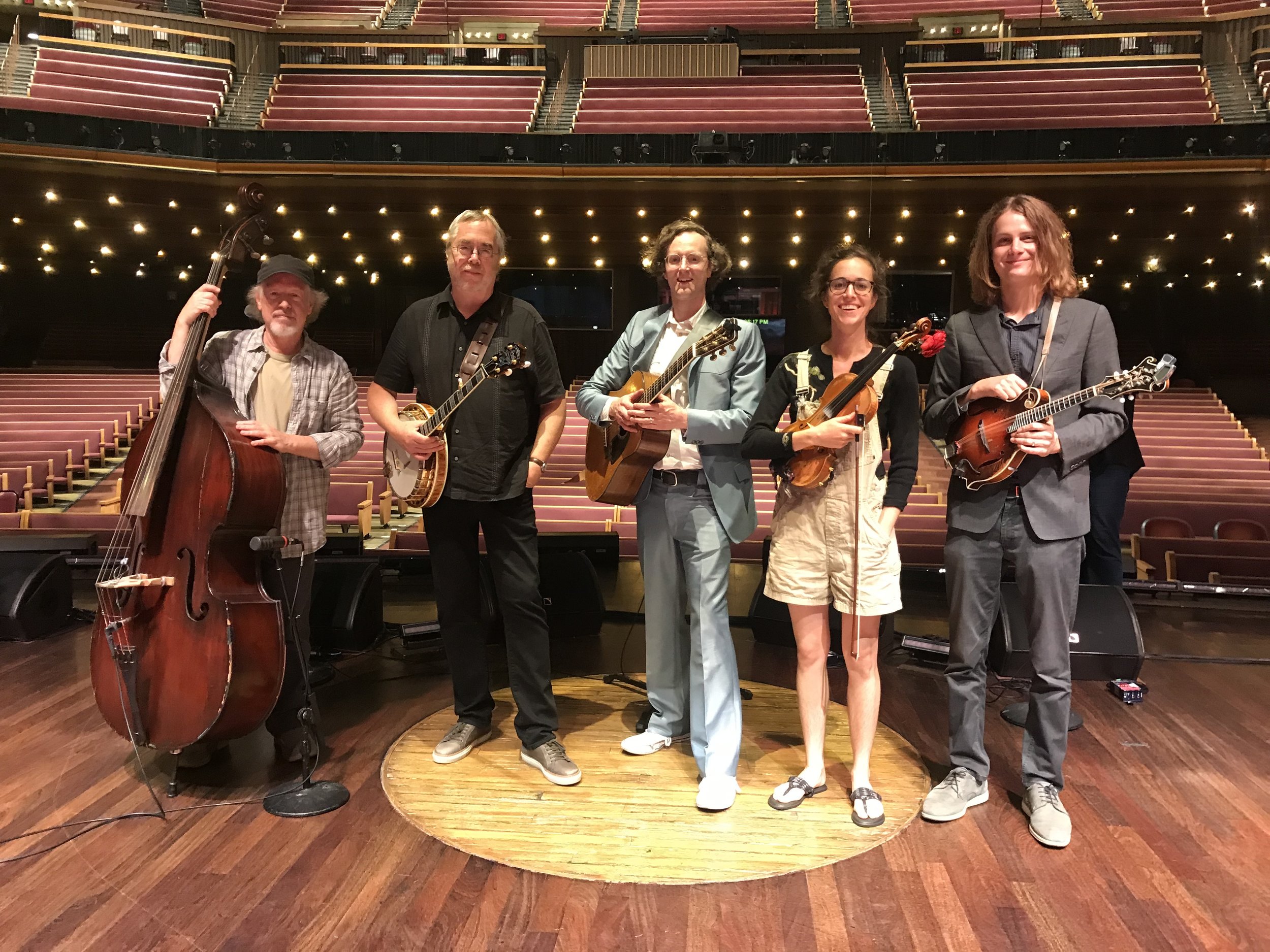A NIGHT AT THE OPRY
with Michael Daves, Brittany Haas, Dominick Leslie & Todd Phillips








Over the years, music has afforded me many unforgettable moments and remarkable opportunities: the bands I’ve toured with, the people I’ve met, the places I’ve been. That said, this past weekend in Nashville stands out as a peak experience, for so many reasons. Smack in the middle was the stand-out: The Tony Trischka Band made their Grand Ole Opry debut.
But I’ll back up a little bit. I flew in on Thursday night and had a wonderful evening with two of my favorite people in the world, Bela Fleck and Abigail Washburn, and let’s add in their two amazing children, Juno and Theo.
8:30 the next morning, I did a half hour interview with Bill Cody on Clear Channel 650, WSM (same initials as William Smith Monroe). Played my John Henry and Bill Monroe medleys. Bill was very knowledgeable and made me feel right at home. Rhonda Vincent was in the slot just before me and we had a nice time catching up. WSM is located at the Opryland Hotel, which is a massive, maze-like structure, with gardens, waterfalls and ample ambient noise. In fact, at breakfast, the server at the hotel restaurant had a hard time discerning my order of biscuits and gravy so I wound up with brussels sprouts and liver.
I went back to Bela’s after WSM, and did an hour long interview with Tom Power of the CBC and his “No Part of Nothin’” podcast. Besides being a banjo player, which is always a plus, Tom knew his stuff which made for an in-depth exchange. His interview with Bela followed shortly thereafter.
I spent the rest of the afternoon rehearsing with the band for our appearance Friday night at Nashville’s storied Station Inn. Michael Daves on guitar and vocals, Brittany Haas on fiddle, Dominick Leslie on mandolin and Todd Phillips on bass. Couldn’t ask for better than that.
The show that evening gave me as much joy as I’ve ever had on stage. Full house and cameos by Kristin Andreassen, Critter (Chris Eldridge), Jen Larsen and John Mailander. Nothing beats a banjo/fiddle duet with Brittany Haas and her bionic bowing arm at the beginnings of “Fox Chase” and “Salt River.” Some new friends from my South Africa Banjo Safari also showed up unexpectedly with their families. ‘Twas a joyous night!
Early Saturday afternoon, I headed out to Gallatin, TN to meet Michael Daves for an interview with one of my all time heroes, Jesse McReynolds, of Jim and Jesse fame. The result of this time together is that Michael & I will each have the interview available on our respective ArtistWorks websites some time in the near future. Jesse, at the age of 90, is the oldest member of the Grand Ole Opry. He’s a total gentleman and continues to create new music. Technical note: Jesse demonstrated how he’s been working on furthering his split string mandolin technique, wherein he frets one string of one of the four pairs of doubled strings to create a harmony. He’s added a false, slightly longer nail to his left hand pinky finger to expedite this technique. Though he says he no longer employs his groundbreaking cross picking style, inspired by Earl Scruggs’s three finger picking, he mentioned that back in the day he would have a wider spacing at the nut and bridge to make it easier to execute. The real thrill of our afternoon with Jesse came when we got to pick a few tunes with him. We started with “Sitting on Top of the World,” with Michael singing harmony. The chords Jesse used were the standard ones until the very last “I’m sitting on top of the world,” wherein, in the key of G, he went F, C and G. He said he always likes to do something a little bit different. A perfect case in point. I’m beyond grateful to have spent such quality time with this bluegrass legend. It ranks right up there with time spent in the company of Earl and Bill.
The Opry soundcheck was next. At the guardhouse to check in, I was greeted with a “Welcome Tony, great to have you here and congratulations on your Opry debut.” Wasn’t expecting that. He then directed us to Parking Space 28. Imagine my surprise when we pulled in and were met by a metal sign that read, “Reserved, Tony Trischka, Opry Debut, August 24, 2019”. Then, as I was going through the metal detector, the security guard asked, “How’s Syracuse?” That’s my hometown, so someone sure did their research to make me feel welcome. At the last check-in point, I was handed a swag bag with hefty, gorgeous Opry books and an Opry ball cap.
That night, Michael and I each wore outfits formerly owned by fiddler extraordinaire, Tex Logan. It seemed fitting to return something of Tex’s essence to the Opry stage.
We had a chance to watch a couple of the earlier acts on the TV monitor in our dressing room, and waited to see our hosts, The Whites, hit the stage. I’ve known Buck, Sharon, Cheryl and Rosie White since the 70s and they’ve always treated me like family. Someone said earlier in the evening that once you’re in their family, you’re always in their family, and I sure felt it. The Whites started off with a couple of tunes, then Sharon introduced us with some gracious comments about how long we’d known each other. The audience gave us a warm welcome and applauded solos generously. Even though the original Opry was held at the Ryman Auditorium, I could feel the ghosts of country music past as we walked out onto the stage. We worked off of one mic, placed just in front of a circle of original wood flooring from the Ryman. Michael, Brittany, Todd, Dom, and I launched into two of my compositions, first, “West Point of the Eno,” (from World Turning) and then “Fox Chase” (from Territory). The sound was warm and fairly gigantic, befitting a venue of that size. Though the reaction at the end of “Eno” was strong, as we finished “Fox Chase,” the audience erupted. As a New Yorker with a notoriously progressive rep, it was a true thrill and honor to have the Opry open its arms to me.
Sharon was at the side of the stage as we exited and pulled me over to congratulate me. Immediately after, there was country legend Connie Smith waiting to greet me with generous warmth. She hosted an earlier segment and could easily have gone home when she was done, or stayed backstage, but she told me she purposely waited to hear our set, which totally blew me away. Moments later, the Whites finished off their portion of the show with the Original Carter Family’s “Keep on the Sunnyside.” Who could ask for anything more?
Bobby Osborne was also on the show with his Rocky Top Express and after our segment, Michael interviewed him in our dressing room. I came in as they were finishing, and since I’ve been friendly with Bobby over the years, I had a chance to reconnect with him with a lovely conversation. He’s a wonderful man and still has that supernal tenor voice. “Rubeeeee…”. Another one of my major Bluegrass heroes…still doing it.
The next morning, I headed out to a studio just outside of Nashville, to add final mixing touches to a couple of tunes I’d recorded in Durbin, South Africa, at Ladysmith Black Mambazo’s studio. One was a tune I wrote with South African musicians, David Jenkins & Maqhinga Radebe. ”Black Back Jackal” (one of the creatures that we missed on our safari – sounded like a good title for a tune). I also recorded a solo medley on a low C tuned banjo belonging to Abby Washburn, who came in to sing an Emily Dickinson poem I’d put to music (the fourth that I’ve done so far). From the moment she approached the mic, Abby created an emotional spell that left me breathless.
As I’m writing this, the whole weekend seems dream-like. For years, in the traditional country and bluegrass world, I’ve felt like an outsider, an eccentric uncle as per my relationship to the music. Not anymore. Now the Opry has allowed me to feel part of an inclusive extended family.
I think back to the late 60s, while friends were dating or causing trouble, my friend Mike Cloonan and I would drive to the countryside outside of Syracuse on a freezing cold Saturday night in January or February in Mike’s bluegrass VW bug, in the hopes of hearing a song or two by Bill Monroe, The Osborne Brothers or Jim and Jesse on the Grand Ole Opry. Though WSM was punching through with 50,000 watts, the signal would sometimes fade. At that point, we’d pull forward 4 inches, or back 8, until the signal returned.
Now, all these years later, here I was on that very show.
We’ve been invited back, and hopefully this is the beginning of many visits.
- TT
August 30, 2019